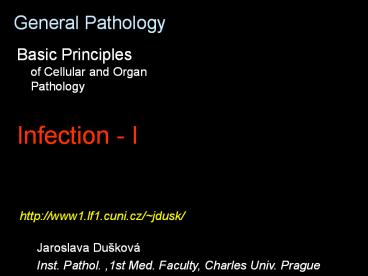Basic Principles of Cellular and Organ Pathology Infection - PowerPoint PPT Presentation
Title:
Basic Principles of Cellular and Organ Pathology Infection
Description:
Basic Principles of Cellular and Organ Pathology Infection - I http://www1.lf1.cuni.cz/~jdusk/ Jaroslava Du kov Inst. Pathol. ,1st Med. Faculty, Charles Univ. Prague – PowerPoint PPT presentation
Number of Views:31
Avg rating:3.0/5.0
Title: Basic Principles of Cellular and Organ Pathology Infection
1
General Pathology
- Basic Principles of Cellular and Organ Pathology
- Infection - I
http//www1.lf1.cuni.cz/jdusk/
Jaroslava Dušková Inst. Pathol. ,1st Med.
Faculty, Charles Univ. Prague
2
Inflammation - causes
- nonliving
- physical
- chemical
- living
- prions (?)
- viral
- bacterial
- mycotic
- parasitic
- AUTOIMMUNE
3
Interaction of Organism and Microorganism Terms
- Bacteriemia (transient)
- Sepsis/ Septicemia
- Pyemia
- Toxemia
- Viremia
4
Bacteriemia
- transient presence of microbes in the
bloodstream
5
Sepsis / Septicemia (Severe Bacteremia)
- increasing numbers of microbes ( their
toxins) in the bloodstream
6
Sepsis/Septicemia
- Def.
- systemic response to infection manifestating as
- tachypnoe gt 20/min.
- tachycardia gt 90/min.
- temperature gt 39 st. C. (ev. lt 36st.C)
- leucocytosis gt 15 000/1?l (ev. lt 4000/1?l)
7
Sepsis Pathogenetic Factors
- Endotoxin, toxins G
- Macrophages
- Cytokins
- NO
- PAF (Platelets
- Activating Factor)
- TNF, IL1
- TNF, IL1, IL6
- NO synthesis
- vasodilation
- coagulation
8
Syndrome of Systemic Inflammatory Response
- Def.
- systemic response to an AGENT
manifestating as - tachypnoe gt 20/min.
- tachycardia gt 90/min.
- temperature gt 39 st. C. (ev. lt 36st.C)
- leucocytosis gt 15 000/1?l (ev. lt 4000/1?l)
- AGENT pancreatitis, injury, burns..
9
Pyemia
- presence of infected thrombemboli bearing
virulent microbes in the bloodstream
10
Toxemia
- presence of microbial toxin (s) without the
microbes themselves in the bloodstream
11
Endotoxin
- lipopolysaccharide component of G- bacteria
outer wall - effects fever, shock, DIC, RDS
- effects mediated by IL-1, TNF
12
Exotoxins -1
- often enzymes (leukocidins, hemolysins,
hyaluronidases, coagulases, fibrinolysins) - others.
13
Exotoxins -2
- diphteria toxin inhibition of cellular
proteosynthesis - botulotoxin block of the cholinergic
transmission - choleratoxin increase in cAMP, losses of
isoosmotic fluid via enterocytes
14
Host Microorganism Encounter
- General
- Natural defenses
- Inflammation
- Immune status
- Successful transmission
- Site of attack
- Number of microorg.
- Pathogenicity
15
Host
- Inflammation
- leucocytes
- macrophages -phagocytosis
- Immune status
- immunity (or lack of it)
- active, passive immunisation, contact
- lymphocytes
- immunoglobulins
- complement
- General
- age, race, nutrition, other diseases (diabetes)
- Natural defenses
- skin, mucose integrity
- mucus, cilliary action, unobstructed flow
- protective secretion (lysosym in tears, gastric
acid, IgA
16
Microorganism
- Successful transmission
- Site of attack
- Number of microorg.
- Pathogenicity invasiveness
- toxin production
- multiplication
- resistence to host
defence mechanisms - ability to cause necrosis
- enzyme release
17
INFECTION versus DISEASE
- Pathogenicity (virulence)
- Incubation Period
- Carrier State
18
Agent Host Interaction
- cytocidal
- stabilised (steady state)
- transformation ONCOGENS
19
Virus Host Cell Interaction
- cytocidal
- stabilised (steady state)
- transformation ONCOGENS
20
Inflammation - causes
- non infectious
- physical
- chemical
- infectious
- prions
- viral
- bacterial
- mycotic
- parasitic
- AUTOIMMUNE
21
Infectious Agents of Humans
- prions
- viruses (DNA, RNA)
- bacteria (incl. chlamydia, mycoplasma,
rickettsia obligatory intracellular parasites) - fungi (yeasts, molds)
- parasites (protozoa, helmints, ectoparasites-
insects lice, mites, ticks spiders)
22
Infectious Agents of Humans
Bacteria
- simple cells prokaryotes
- both DNA and RNA
- cocci, bacilli (AFB!), spirochetes.
- Gram positive /negative
- extra- and/or intracellular
- aerobic/ anaerobic
23
Infectious Agents of Humans Fungi
- complex cells eukaryotes
- both DNA and RNA
- yeasts, molds (hyphae, pseudohyphae)
- PAS, impregnation
- extra- or intracellular
- mostly opportune pathogens
24
Infectious Agents of Humans
Parasites -1
- Protozoa
- complex cells eukaryotes
- both DNA and RNA
- extra- or intracellular
- (Amebas, Trichomonas,Trypanosoma, Toxoplasma,
Plasmodium, Pneumocystis)
25
Infectious Agents of Humans
Parasites -2
- Metazoa (helmints and flukes)
- multicellular
- both DNA and RNA
- flat and round worms
- extracellular
- (Taenia, Ascaris, Enterobius, Trichuris
Echinococcus, Clonorchis, Schistosoma,
Wuchereria)
26
(No Transcript)
27
Infectious Agents of Humans
Parasites -3
- Insecta, Arachnida
- multicellular
- both DNA and RNA
- extracellular
- (Sarcoptes scabiei, fleas, ticks, lice)































